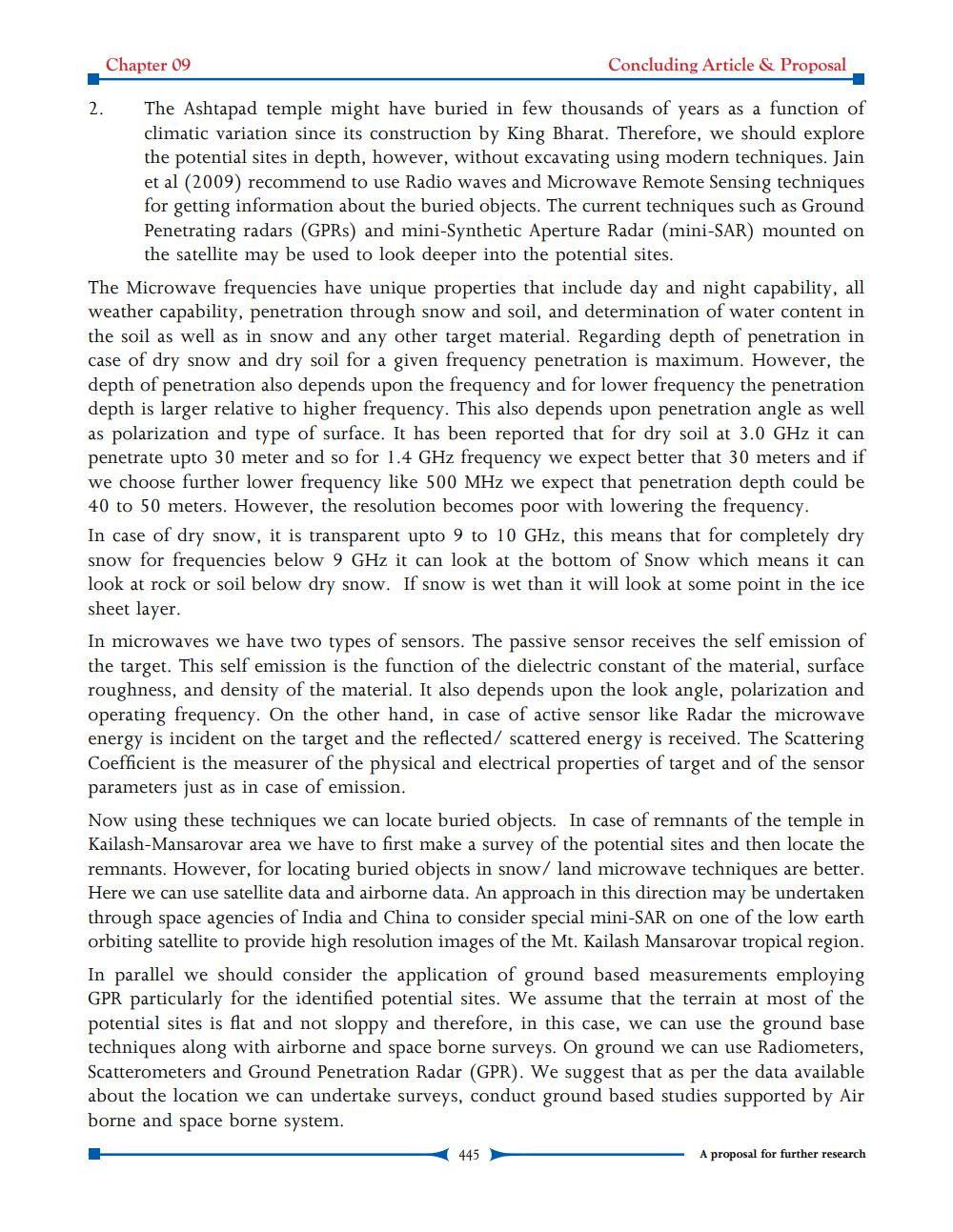________________
2.
Chapter 09
Concluding Article & Proposal
The Ashtapad temple might have buried in few thousands of years as a function of climatic variation since its construction by King Bharat. Therefore, we should explore the potential sites in depth, however, without excavating using modern techniques. Jain et al (2009) recommend to use Radio waves and Microwave Remote Sensing techniques for getting information about the buried objects. The current techniques such as Ground Penetrating radars (GPRS) and mini-Synthetic Aperture Radar (mini-SAR) mounted on the satellite may be used to look deeper into the potential sites.
The Microwave frequencies have unique properties that include day and night capability, all weather capability, penetration through snow and soil, and determination of water content in the soil as well as in snow and any other target material. Regarding depth of penetration in case of dry snow and dry soil for a given frequency penetration is maximum. However, the depth of penetration also depends upon the frequency and for lower frequency the penetration depth is larger relative to higher frequency. This also depends upon penetration angle as well as polarization and type of surface. It has been reported that for dry soil at 3.0 GHz it can penetrate upto 30 meter and so for 1.4 GHz frequency we expect better that 30 meters and if we choose further lower frequency like 500 MHz we expect that penetration depth could be 40 to 50 meters. However, the resolution becomes poor with lowering the frequency.
In case of dry snow, it is transparent upto 9 to 10 GHz, this means that for completely dry snow for frequencies below 9 GHz it can look at the bottom of Snow which means it can look at rock or soil below dry snow. If snow is wet than it will look at some point in the ice sheet layer.
In microwaves we have two types of sensors. The passive sensor receives the self emission of the target. This self emission is the function of the dielectric constant of the material, surface roughness, and density of the material. It also depends upon the look angle, polarization and operating frequency. On the other hand, in case of active sensor like Radar the microwave energy is incident on the target and the reflected/ scattered energy is received. The Scattering Coefficient is the measurer of the physical and electrical properties of target and of the sensor parameters just as in case of emission.
Now using these techniques we can locate buried objects. In case of remnants of the temple in Kailash-Mansarovar area we have to first make a survey of the potential sites and then locate the remnants. However, for locating buried objects in snow/ land microwave techniques are better. Here we can use satellite data and airborne data. An approach in this direction may be undertaken through space agencies of India and China to consider special mini-SAR on one of the low earth orbiting satellite to provide high resolution images of the Mt. Kailash Mansarovar tropical region. In parallel we should consider the application of ground based measurements employing GPR particularly for the identified potential sites. We assume that the terrain at most of the potential sites is flat and not sloppy and therefore, in this case, we can use the ground base techniques along with airborne and space borne surveys. On ground we can use Radiometers, Scatterometers and Ground Penetration Radar (GPR). We suggest that as per the data available about the location we can undertake surveys, conduct ground based studies supported by Air borne and space borne system.
445
A proposal for further research




